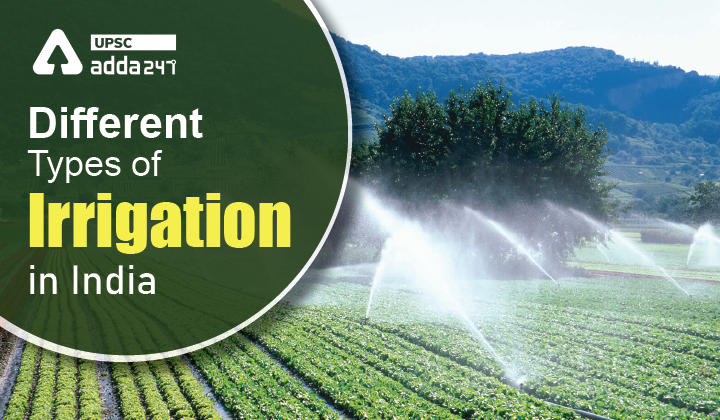Table of Contents
Types of Irrigation in India
Different types of irrigation: India, since ancient times, follows many types of irrigation facilities to increase production and productivity of the crops. Types of irrigation are very much relevant for the UPSC exam as it is directly given in the UPSC GS paper 3. In this article, we will discuss all the aspects of irrigation like irrigation definition, irrigation importance and types of irrigation.
What is irrigation?
- Irrigation definition: In agriculture, irrigation means artificial application of water on land to assist the production of crops, or foster plant growth.
Importance of irrigation
- Consistent production: As climate in India is majorly monsoonal, depending on rain could not serve the farmers round the year. Also, agricultural production is affected due to irregular, insufficient or uncertain rain. Proper irrigation systems can secure uninterrupted production.
- Productivity of land: The productivity of irrigated land is more than the un-irrigated land. Higher productivity in turn helps the farmers get better return of their produces, beside controlling the inflation in the economy.
- Seed growth: Water is necessary for seem germination as seeds cannot grow in dry soil. With the help of irrigation supply, the required moisture content of soil for the growth of seed can be ensured.
- Multiple cropping: With irrigation, multiple cropping in a year is possible. In many regions of India, crop diversification is practiced with the help of irrigation.
- Basic nutrient: Irrigation helps in supplying the required amount of hydrogen & oxygen to the soil, which is important for the proper development of plant root.
- Cultivable land: Bringing more land under cultivation is also possible through proper irrigation.
- Reduces poverty: Irrigation can play a protective role during the period of drought & famines. Income and employment are closely related to the agricultural output for the farm households. Irrigation increases production, which in turn increases the income of farmers.
Types of irrigation
- There are three methods of irrigation: Surface irrigation, sub-surface irrigation, and Pressurized irrigation.
Surface irrigation
- It is the oldest and most common form of irrigation in India.
- Almost 90% of total area are covered under this type of irrigation.
- It is labour intensive
- It is most suitable for crops having low to moderate infiltration rates.
- There are 5 types of surface irrigation: Canal irrigation, Border irrigation, Check basin irrigation, Surge irrigation, and Furrow irrigation.
Canal irrigation
- Canals are an effective source of irrigation in areas of low-level relief, deep fertile soils, perennial source of water and extensive command area.
- Canal construction is not possible in peninsular region of India due to rocky and uneven terrain. Therefore, the main concentration of canal irrigation is in the northern plain of India, especially in the regions of UP, Punjab, Bihar and Haryana.
Border irrigation
- Under this, land is first divided into borders (long parallel strips).
- It is not used in coarse sandy soils.
- It is suitable for crops like wheat, barley and legumes.
- It is not suitable for rice.
Check basin irrigation
- It is the most common surface irrigation method.
- Under this, field is divided into smaller units.
- Uniform land sloped are adaptable.
Surge irrigation
- It means applying water into furrows in a series of relatively short ON and Off times of irrigation cycle.
- The efficiency of this type of irrigation is 85-90%.
Furrow irrigation
- This type of irrigation is mostly used for row crops.
- Under this, furrows are formed between the crops.
- Water is then applied by small running streams in furrows between the crop rows.
- It is suitable for most crops except sandy.
We will discuss about the sub-surface irrigation and pressurized irrigation like drip irrigation and sprinkler irrigation in our next article.
Read current affairs for UPSC





 TSPSC Group 1 Question Paper 2024, Downl...
TSPSC Group 1 Question Paper 2024, Downl...
 TSPSC Group 1 Answer key 2024 Out, Downl...
TSPSC Group 1 Answer key 2024 Out, Downl...
 UPSC Prelims 2024 Question Paper, Downlo...
UPSC Prelims 2024 Question Paper, Downlo...
